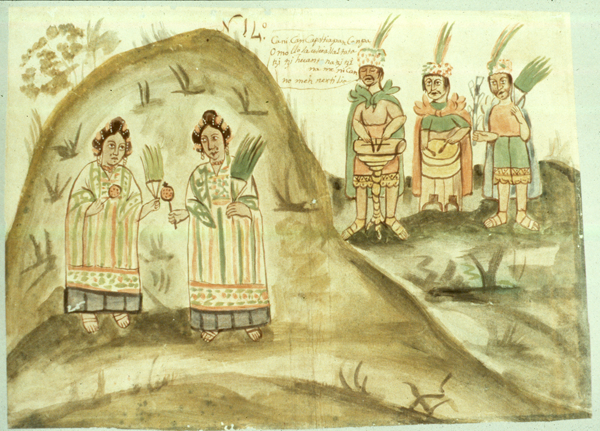full view, Scene 14
"Here is represented the place of the god Copistlin, where our fathers and mothers gathered to sing and dance in the manner here shown."
[Source: Frederick Starr's English translation of the text found in the corresponding scene in the version he saw in the pueblo in 1898, published in his book, The Mapa de Cuauhtlantzinco (Chicago: University of Chicago Press, 1898), p. 16]
Starr's footnote: "Native dress is well shown in many of the pictures, but nowhere better than here. It is thus described by Rojas: “Their dress in times of peace consisted of a tilmatl or white cotton mantle, square, with the two ends tied together on the right shoulder; of a narrow breech-clout, and of shoes like sandals, similar to those which the ancients used to wear….. The women used to wear a many-colored cotton skirt, coming down to the ankle, or a little above, with plaits and folds and paintings called naguas. Over the naguas was worn a guipilli, like cloak or breast-cloth without sleeves, the border stitched with cotton, and with tufts of rabbit-hair and feathers of ducks for ornament. In front and behind, these guipilles show a square portion, on which many figures of animals, birds, and fishes are executed with gold and in colors.” (Band.: 1. c. 215).
Such embroidered decorations as are here described are still worn on modern huipillis. They are worked in black, red, or blue yarns, or with bright beads. Some of the men in the pictures wear in addition to the articles described by Rojas, wide-legged trousers reaching to their knees, bordered below with an embroidered band, In the picture two women dance, while three men supply the music. The dancers carry rattles and feather wands with which they keep time: the first of the men beats upon the horizontal drum or teponastli: the second beats upon the upright drum or huehuetl: the third holds a scepter and a feathered wand. The men wear head circlets from which rise plumes. All these instruments of music and accoutrements for the dance may still be found among the Indians of Mexico. The hair-dressing of the women is notable: it resembles that of the women of Coatlan and Yalalag in Oaxaca today." [p. 16]
